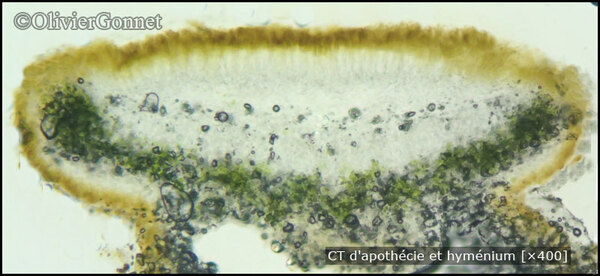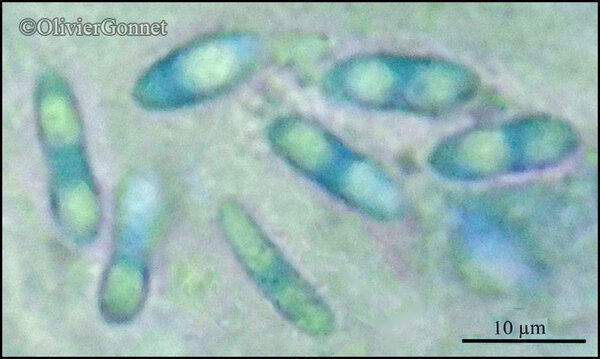Protoparmelia nitens (Pers.) Sancho & A. Crespo
Actas del VI Simp. Nac. Bot. Cript., Granada: 445, 1987. Basionym: Patellaria nitens Pers. - Ann. Wetter. Gesellsch. Ges. Naturk., 2: 12, 1811 (1810).
Synonyms: Lecanora nitens (Pers.) Ach.
Distribution: N - TAA, Piem, VA, Lig.
Description: Thallus crustose, episubstratic, rimose-areolate to warted, chestnut to reddish brown, the areoles mostly contiguous, irregular in shape, flat to slightly convex, with a smooth, not folded surface, epruinose. Cortex with a brown upper layer overlain by an epinecral layer; medulla white or pale yellowish, I-. Apothecia lecanorine, usually abundant, adnate, round or weakly angular, 0.5-1 mm across, with a brown-black, usually flat, epruinose disc and a thin thalline margin. Thalline exciple corticate; proper exciple poorly delimited, brown in outer part, colourless within; epithecium olive-brown to yellowish brown; hymenium colourless; paraphyses coherent, branched in upper part, rarely anastomosing; hypothecium colourless or pale yellow. Asci 8-spored, clavate, approaching the Lecanora-type, with a well-developed amyloid tholus and a distinct, non-amyloid axial mass. Ascospores 1-celled, hyaline, with rounded apices, 7-14 x 3-5 µm. Photobiont chlorococcoid. Spot tests (better visible on microscopic sections): medulla K-, C-, KC- or KC+ fleeting pink, P-. Chemistry: unknown. Note: a poorly known and often misunderstood silicicolous species. The Italian records, especially those from upland areas, need re-confirmation.
Growth form: Crustose
Substrata: rocks
Photobiont: green algae other than Trentepohlia
Reproductive strategy: mainly sexual
Poorly known taxon in need of further study
Commonnes-rarity: (info)
Alpine belt: absent
Subalpine belt: absent
Oromediterranean belt: absent
Montane belt: very rare
Submediterranean belt: absent
Padanian area: absent
Humid submediterranean belt: very rare
Humid mediterranean belt: very rare
Dry mediterranean belt: absent

Predictive model
Herbarium samples
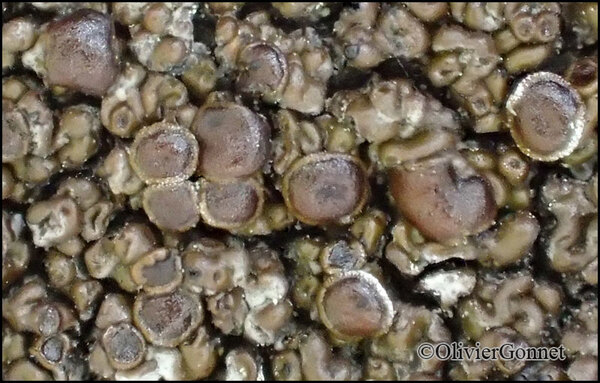
Courtesy Danièle et Olivier Gonnet - Source: https://www.afl-lichenologie.fr/Photos_AFL/Photos_AFL_P/Text_P_5/Protoparmelia_nitens.htm
France, 22/07/2015 - Milly-la-Forêt, site de la Boulignère, alt. 90 m - Essonne
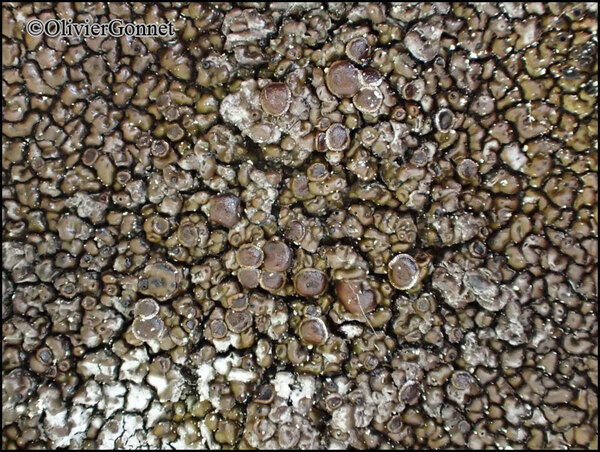
Courtesy Danièle et Olivier Gonnet - Source: https://www.afl-lichenologie.fr/Photos_AFL/Photos_AFL_P/Text_P_5/Protoparmelia_nitens.htm
France, 22/07/2015 - Milly-la-Forêt, site de la Boulignère, alt. 90 m - Essonne
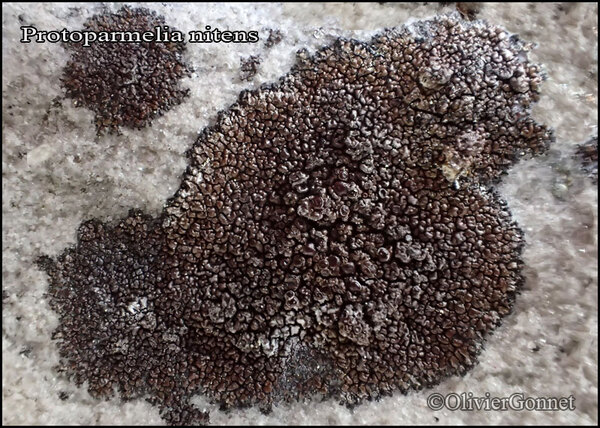
Courtesy Danièle et Olivier Gonnet - Source: https://www.afl-lichenologie.fr/Photos_AFL/Photos_AFL_P/Text_P_5/Protoparmelia_nitens.htm
France, 22/07/2015 - Milly-la-Forêt, site de la Boulignère, alt. 90 m - Essonne
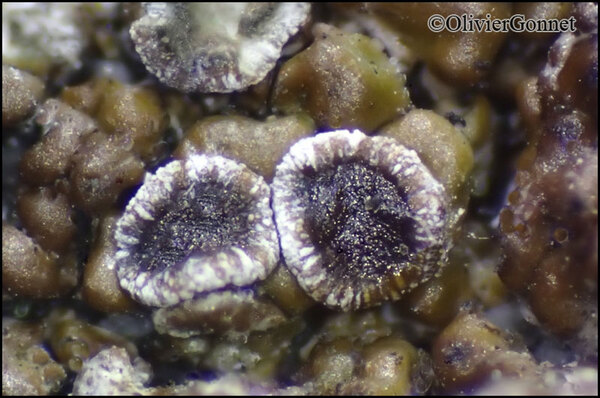
Courtesy Danièle et Olivier Gonnet - Source: https://www.afl-lichenologie.fr/Photos_AFL/Photos_AFL_P/Text_P_5/Protoparmelia_nitens.htm
France, 22/07/2015 - Milly-la-Forêt, site de la Boulignère, alt. 90 m - Essonne

Courtesy Danièle et Olivier Gonnet - Source: https://www.afl-lichenologie.fr/Photos_AFL/Photos_AFL_P/Text_P_5/Protoparmelia_nitens.htm
France, 22/07/2015 - Milly-la-Forêt, site de la Boulignère, alt. 90 m - Essonne
Growth form: Crustose
Substrata: rocks
Photobiont: green algae other than Trentepohlia
Reproductive strategy: mainly sexual
Poorly known taxon in need of further study
Commonnes-rarity: (info)
Alpine belt: absent
Subalpine belt: absent
Oromediterranean belt: absent
Montane belt: very rare
Submediterranean belt: absent
Padanian area: absent
Humid submediterranean belt: very rare
Humid mediterranean belt: very rare
Dry mediterranean belt: absent

Predictive model
| Herbarium samples |

Courtesy Danièle et Olivier Gonnet - Source: https://www.afl-lichenologie.fr/Photos_AFL/Photos_AFL_P/Text_P_5/Protoparmelia_nitens.htm
France, 22/07/2015 - Milly-la-Forêt, site de la Boulignère, alt. 90 m - Essonne

Courtesy Danièle et Olivier Gonnet - Source: https://www.afl-lichenologie.fr/Photos_AFL/Photos_AFL_P/Text_P_5/Protoparmelia_nitens.htm
France, 22/07/2015 - Milly-la-Forêt, site de la Boulignère, alt. 90 m - Essonne

Courtesy Danièle et Olivier Gonnet - Source: https://www.afl-lichenologie.fr/Photos_AFL/Photos_AFL_P/Text_P_5/Protoparmelia_nitens.htm
France, 22/07/2015 - Milly-la-Forêt, site de la Boulignère, alt. 90 m - Essonne

Courtesy Danièle et Olivier Gonnet - Source: https://www.afl-lichenologie.fr/Photos_AFL/Photos_AFL_P/Text_P_5/Protoparmelia_nitens.htm
France, 22/07/2015 - Milly-la-Forêt, site de la Boulignère, alt. 90 m - Essonne

 INDEX FUNGORUM
INDEX FUNGORUM
 GBIF
GBIF
 DOLICHENS
DOLICHENS
